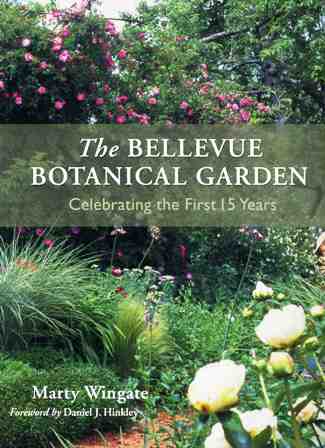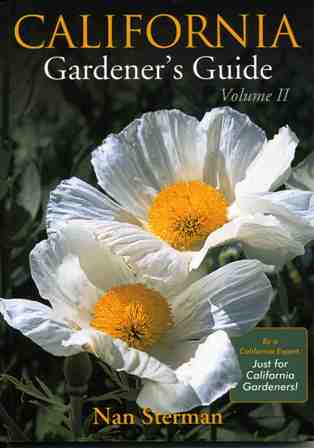The Garden Library: book reviews
October 17th, 2007
 Reading great garden writing is one of life’s joys. And one of my favorite pastimes is to spend time savoring the words written by friends and fellow garden writers.
Reading great garden writing is one of life’s joys. And one of my favorite pastimes is to spend time savoring the words written by friends and fellow garden writers.
Here are two books I recently reviewed for Pacific Horticulture magazine (an important resource for anyone who gardens in the West).
The Bellevue Botanical Garden: Celebrating the First 15 Years, by Marty Wingate (2007, The Bellevue Botanical Garden Society), 9×12 inches, 112 pages, $19.95. To order: Bellevue Botanical Garden.
“The moment you enter the garden, you will sense that the BBG is as personal as a beloved private garden,” writes Nancy Davidson Short in her back-cover tribute to this book. Indeed, in author Marty Wingate’s colorful narrative of this relatively young garden, the passion of its supporters’ “ownership” influences all aspects of the Bellevue Botanical Garden’s inception and evolution.
To celebrate the garden’s first 15 years, the BBG Society asked Wingate and book designer Virginia Hand to sift through decades of archival material dating back to the 1940s, conduct first-person interviews, and edit hundreds of images contributed by volunteer and professional horticultural photographers. The result is a timely and timeless document that captures the roots of BBG – from the gift of land by benefactors Cal and Harriet Shorts to the partnership between the BBG Society and the City of Bellevue’s Parks Department.
Revealing her talents as a garden tour guide and garden writer, Wingate escorts her readers through BBG’s multilayered narrative, stopping at important venues to recount a small historical detail, or focusing closely on noteworthy plant specimens. She enthusiastically retells the story of this “living jewel” and its influence on regional, national and international audiences who number 300,000 visitors each year.
The book’s most inspiring section covers “The Gardens” — including the Entrance Garden, Northwest Perennial Alliance Borders, Yao Japanese Garden, Shorts Ground Cover Garden, Waterwise Garden, Alpine Rock Garden, Fuchsia Garden, Native Discovery Garden and Lost Meadow/Loop Trail.
Illustrated with exquisite photographs of plant combinations and garden portraits, the history of these specialty gardens is also shared through interviews with key volunteers who helped design, install, tend to and nurture their creation.
And ultimately, that’s the heart and soul of this book: How members of the gardening community – from avid lay gardeners to professional landscape designers and horticultural educators – turned the dream of a botanical garden into a beautiful reality for the public.
California Gardener’s Guide, Volume II, by Nan Sterman (2007, Cool Springs Press) 7×10 inches, 271 pages, $24.95. To order: Plant Soup.
In the interest of full disclosure, I admit to being more than a little familiar with the format of Nan Sterman’s excellent new book, California Gardener’s Guide, Volume II. In 2005, Mary Robson and I coauthored the Washington and Oregon Gardener’s Guide, its Northwest cousin.
I am a newcomer to California, having relocated to Ventura County in August 2006. And I’ve been waiting for this book ever since. Having given up my Seattle garden, along with plants like hostas and hellebores that loved shade and moist growing conditions, I’m faced with a new backyard, a tabula rasa for a novice to California gardening. Like many gardeners, I want to grow and nurture plants that are appropriate for my surroundings, including ornamental natives.
Sterman, a California gardening expert who embraces sustainable practices such as designing with drought-tolerant plants, serves up her top recommendations: 186 plants for California’s diverse growing areas.
This is no small task, as Sterman notes in her introduction: “From north to south and east to west, there are dramatic differences in vegetation, geology, topography and climate.”
Before revealing her recommendations for the “best of the best” — annuals/biennials, bulbs, fruits, groundcovers, herbs, ornamental grasses, perennials, shrubs, succulents, trees and vines — Sterman introduces the beginning gardener (or California newbies like me) to the state’s five primary growing regions. She includes useful charts that outline average annual rainfall, maximum and minimum temperatures for each region, including: the coast, inland valleys, the Central Valley, low deserts and high deserts.
With Mediterranean conditions accounting for much of the state’s geogrpahy, Sterman zeroes in on native plants and those from other Mediterranean regions adapted to California’s low-water conditions. She also covers “thirstier” plants, edibles and ornamentals that are noteworthy for their “return on investment” (fruit, berries or fragrance). In the one-page plant profiles, Sterman makes note of species with low water, moderate water and high water needs. Useful icons also indicate whether the plant attracts butterflies or hummingbirds, supports bees, is edible, fragrant, produces fruits, is long-blooming or appropriate as a cut flower, provides food or shelter for wildlife, has colorful foliage, is drought tolerant, a good container plant, grows well in Mediterranean conditions, adds a tropical look to the garden, tolerates coastal conditions and is a California native.
I really appreciate the “zone” graphic which shows a tiny map of California on each page (this is a clever feature that I wish Mary and I had used in our version of the state plant guide). The map is shaded to allow readers to tell at-a-glance whether a plant is hardy for the region in which they live; Sterman also includes the estimated minimum temperature for the plant.
Now I can take the California Gardener’s Guide along on plant-shopping excursions and use it to find something other than the ubiquitous agapanthus (okay, we thought that was a “rare” plant in Seattle: now I see it growing in clumps at the corner gas station!).











August 22nd, 2009 at 3:08 am
I like this magazine, full of useful facts.
Ubiquitous Agapanthus used to be a rare plant.
Nice post.
February 5th, 2010 at 9:25 pm
Great! The articles so far have been full of great material. Glad to hear the serious will continue. Keep ’em coming!
March 12th, 2010 at 7:01 am
Hi – It’s great to read such interesting writing on the Web as I have been able to fiind here. I agree with much of what is written here and I’ll be coming back to this website again. Thanks again for posting such great reading material!!
March 16th, 2010 at 9:07 am
Ok, i think i will save this for thenext time I’ll have to argue with Frank (friend of mine) about it! I wasn’t wrong 😀